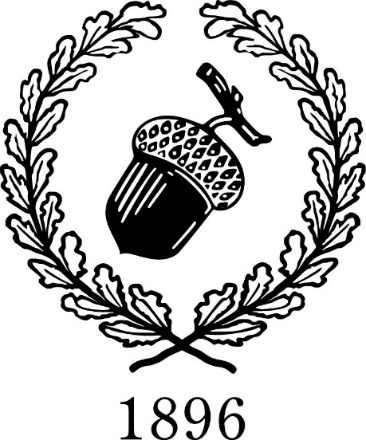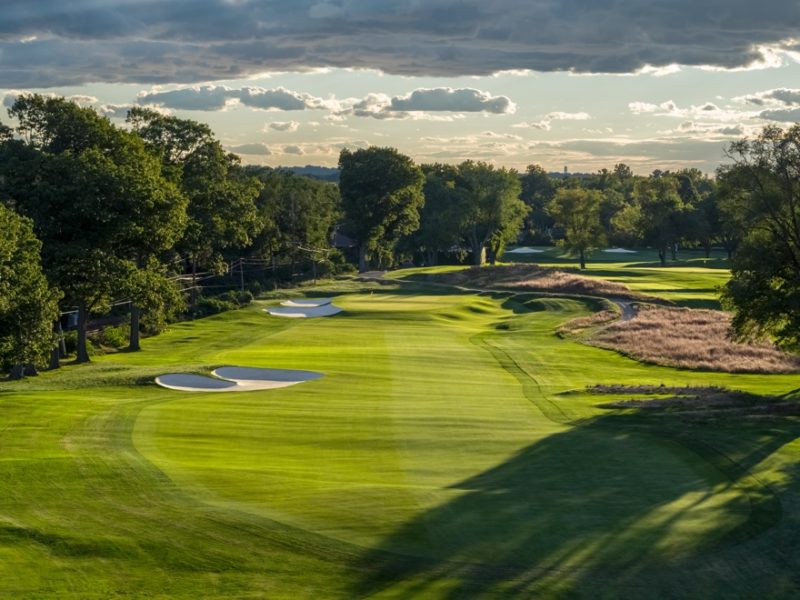Fazio Design turns historic Long Island club into strategic delight
GLEN COVE, New York – The renovation of Nassau Country Club’s historic layout was completed in October and looks forward to plenty of play, and accolades, as the winter turns to spring. The existing course has undergone numerous changes over 122 years – both natural and manmade – with the most recent work conducted by Fazio Design under the guidance of Tom Marzolf, Senior Design Associate, and Bryan Bowers, Design Associate.
The scope of work included:
- Removal of all old bunkers (note: Course went from 114 bunkers to 48)
- Placing bunkers in the proper landing zones based on modern distances
- Tree removal for better fairway alignment
- Fairway reductions and extensions
- Added low-mown, bent grass green edge surrounds on 16 holes, placing an emphasis on short game options
- Cart path removal and redirection
- Addition of both forward and back tees (the par-70 course eventually will play close to 7,200 yards)
- Reshaping green surrounds
“The course dramatically turned into a shot maker’s strategic-thinking course,” explained Marzolf. “Before, the bunkers were all 180 to 225 yards off the tee and there were a lot of them, many in clusters. That was very tough on seniors, ladies, and children playing the course. But those same bunkers weren’t in play for the better player.”

Marzolf explained that they also shaved the bentgrass turf very low, around both the greens and bunkers.
“I think the game is headed in that direction because it’s a lot of fun,” Marzolf said. “For an average or lesser skilled player, it’s easier: They can roll the ball, putt it from off the green, and don’t need a lot of power to hit out of rough. The really good player with a tight lie must think about how to play it—putt up the slope, bump into the hill, hit a flop shot?
“So, it’s harder for good players and easier for high handicappers, which is perfect.”
The new bunkers are big and bold, what Marzolf calls “Australian style, a MacKenzie look”—deep and flashed with the turf cut low right to the lip, like Augusta National. As for the fairway bunkers, they aren’t off in the rough but along the fairways, even poking and protruding into them in the better-player landing areas.
“If you don’t respect the bunkers’ location, your ball will roll in. So do you play short, play to the side, or try to carry them?”
Befitting a course with so much history, one corner of it has a very different look. On holes 5 and 12, Marzolf created an homage to architect Seth Raynor in an area where they know he did work in 1914-15. Both holes have the square-edged, rectangular-form bunkers Raynor is famous for, and the par-three 5th hole retains his classic thumbprint green.
But everywhere else, the look is big and bold, shaped and very smooth with a clean look that Marzolf said is easier to maintain.
“This was a big change for them, and it will help them for years to come. It will generate more interest from better players interested in golf at the highest level and help separate Nassau from the clubs around it.”
Fazio Design first came to Nassau Country Club around 2011 when the course was losing its greens to a nematode infestation. After Fazio’s team presented a plan to restore the greens in an historically accurate way, Marzolf went a step further, creating a master plan of what the course “could be.”
According to Marzolf, the course didn’t have the look of an old, historic Northeast club. Most noticeably, “a good player would play that course and never hit a ball into a fairway bunker. They’d fly every one.” At the time, the course had 114 bunkers, most of them old and in need of new sand and drainage. Rather than rebuild the old bunkers, in 2019 the club accepted Marzolf’s plan to redo how the course played.
In early 2020, just as the club and Fazio Design were set to go ahead with an updated master plan, Covid-19 hit, and the project was shut down. That fall, the club agreed to an even more extensive renovation, which started and finished in 2021.
The course has a long and varied design history, touched by numerous golf course architects over the decades.
When the club was formed in 1896, the six holes designed by Tom Bendelow, who would eventually create more than 400 courses in the U.S. and Canada, were expanded to a nine-hole layout.
The course that exists today got its beginnings in 1899 when the club moved to its present location and a special Club Committee, led by the club’s first president, Harvey Murdoch, took on the design itself. Numerous modifications were made over the following years—some in response to the acceptance of the longer Haskell ball—but no “recognized” architect seems to have contributed until 1914-15, when Raynor did some work after the club purchased an additional 10 acres.
In the early 1920s, after the club purchased another 22 acres, Herbert Strong created what the Green Committee chairman at the time called “an entirely new course.” There is also evidence that Devereux Emmet worked on the course around 1920, perhaps designing a new 14th green.
Whoever did what, the course remained very much intact with only minor modifications for more than 50 years. In the 1970s, golf course superintendent Charlie Brett took out some bunkers that were no longer in play, expanded some greens, and lengthened a few holes; in the early ‘80s, the opening hole was modified to allow the construction of a practice area, a plan that was reviewed by Rees Jones.
In 1997, Bob Cupp redid all the bunkers on the golf course. In 2004, architect Cynthia Dye McGarey, Pete Dye’s niece, turned the par-four 3rd and 4th holes into a par three and a par five.
The chronology of golf course architects includes:
- 1894 – Tom Bendelow. (This was the original 6-hole course, used until the club reformed and moved in 1899.)
- 1899 – Committee of members led by club president Harvey Murdoch, with input from frequent visitor Walter Travis. The course opened July 4th; regular play started in August.
- 1914 – Seth Raynor
- 1920 – Devereux Emmet
- 1922 – Herbert Strong
- 1980s – Rees Jones
- 1997 – Bob Cupp
- 2004 – Cynthia Dye McGarey
- 2011-present – Fazio Design (led by Tom Marzolf)
Nassau Country Club is a member-owned, private country club on the North Shore of Long Island. For more than 100 years, Nassau Country Club has provided excellence in golf and promoted fellowship among its members. While Nassau’s premier golf experience continues to draw many new members, outstanding racquets, aquatics, and youth programs make Nassau an ideal club for the entire family.
For additional information, access the club’s web site at www.nassaucc.com.


